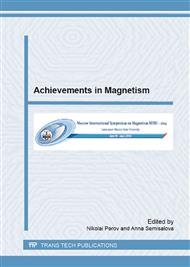p.399
p.403
p.407
p.411
p.415
p.419
p.423
p.427
p.431
Simultaneous Localization of Electrons in Different Δ-Valleys in Ge/Si Quantum Dot Structures
Abstract:
In the present work the possibility of simultaneous localization of two electrons in Δ100 and Δ001 valleys in ordered structures with Ge/Si quantum dots (QD) was verified experimentally by electron spin resonance (ESR) method. ESR spectra obtained for the ordered ten-layered QD structure in the dark shows the signal corresponding to electron localization in Si at the Ge QD base edges, in Δ100, Δ010 valleys (gzz=1.9985, gin-plane=1.999). Light illumination causes the appearance of a new ESR line (gzz=1.999) attributed to the electrons in Δ001 valley localized at the QD apexes. Observed effect is explained by enhancement of electron confienment near QD apex by Coloumb attraction to the photogenerated hole trapped in Ge QD.
Info:
Periodical:
Pages:
415-418
Citation:
Online since:
July 2015
Keywords:
Price:
Сopyright:
© 2015 Trans Tech Publications Ltd. All Rights Reserved
Share:
Citation:


